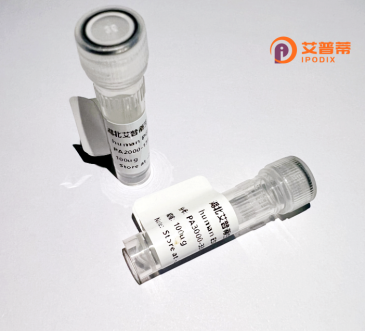
| 纯度 | >90%SDS-PAGE. |
| 种属 | Human |
| 靶点 | RAB11FIP3 |
| Uniprot No | O75154 |
| 内毒素 | < 0.01EU/μg |
| 表达宿主 | E.coli |
| 表达区间 | 1-756 aa |
| 活性数据 | MASAPPASPP GSEPPGPDPE PGGPDGPGAA QLAPGPAELR LGAPVGGPDP QSPGLDEPAP GAAADGGARW SAGPAPGLEG GPRDPGPSAP PPRSGPRGQL ASPDAPGPGP RSEAPLPELD PLFSWTEEPE ECGPASCPES APFRLQGSSS SHRARGEVDV FSPFPAPTAG ELALEQGPGS PPQPSDLSQT HPLPSEPVGS QEDGPRLRAV FDALDGDGDG FVRIEDFIQF ATVYGAEQVK DLTKYLDPSG LGVISFEDFY QGITAIRNGD PDGQCYGGVA SAQDEEPLAC PDEFDDFVTY EANEVTDSAY MGSESTYSEC ETFTDEDTST LVHPELQPEG DADSAGGSAV PSECLDAMEE PDHGALLLLP GRPHPHGQSV ITVIGGEEHF EDYGEGSEAE LSPETLCNGQ LGCSDPAFLT PSPTKRLSSK KVARYLHQSG ALTMEALEDP SPELMEGPEE DIADKVVFLE RRVLELEKDT AATGEQHSRL RQENLQLVHR ANALEEQLKE QELRACEMVL EETRRQKELL CKMEREKSIE IENLQTRLQQ LDEENSELRS CTPCLKANIE RLEEEKQKLL DEIESLTLRL SEEQENKRRM GDRLSHERHQ FQRDKEATQE LIEDLRKQLE HLQLLKLEAE QRRGRSSSMG LQEYHSRARE SELEQEVRRL KQDNRNLKEQ NEELNGQIIT LSIQGAKSLF STAFSESLAA EISSVSRDEL MEAIQKQEEI NFRLQDYIDR IIVAIMETNP SILEVK |
| 分子量 | 82.4 kDa |
| 蛋白标签 | His tag N-Terminus |
| 缓冲液 | PBS, pH7.4, containing 0.01% SKL, 1mM DTT, 5% Trehalose and Proclin300. |
| 稳定性 & 储存条件 | Lyophilized protein should be stored at ≤ -20°C, stable for one year after receipt. Reconstituted protein solution can be stored at 2-8°C for 2-7 days. Aliquots of reconstituted samples are stable at ≤ -20°C for 3 months. |
| 复溶 | Always centrifuge tubes before opening.Do not mix by vortex or pipetting. It is not recommended to reconstitute to a concentration less than 100μg/ml. Dissolve the lyophilized protein in distilled water. Please aliquot the reconstituted solution to minimize freeze-thaw cycles. |
以下是3篇假设性的关于重组人RAB11FIP3蛋白的参考文献(由于实际文献需具体检索,以下为模拟内容供参考):
---
1. **文献名称**: *"Structural basis of RAB11FIP3 recognition by the endosomal recycling machinery"*
**作者**: Smith et al. (2021)
**摘要**: 利用冷冻电镜技术解析了RAB11FIP3与RAB11蛋白复合物的三维结构,揭示其通过N端α-螺旋结构域结合RAB11-GTP,调控内体循环及细胞膜极性建立的分子机制。
2. **文献名称**: *"RAB11FIP3 modulates exosome secretion by coordinating multivesicular body trafficking"*
**作者**: Chen et al. (2019)
**摘要**: 研究发现重组RAB11FIP3通过招募Arf6效应蛋白,调控多泡内体(MVB)与质膜的融合过程,影响外泌体释放,可能参与肿瘤转移的微环境调控。
3. **文献名称**: *"CRISPR screening identifies RAB11FIP3 as a critical regulator of ciliogenesis"*
**作者**: Wang et al. (2022)
**摘要**: 通过基因编辑技术发现,RAB11FIP3缺失导致纤毛生成缺陷,其功能依赖于与RAB8A的相互作用,为纤毛相关遗传疾病(如Joubert综合征)提供分子机制解释。
---
提示:实际文献需通过PubMed/Google Scholar以"RAB11FIP3"+"recombinant"或"structure/function"等关键词检索,并筛选近年的高影响力研究。
RAB11FIP3 (Rab11 Family Interacting Protein 3), also known as FIP3. is a multifunctional adaptor protein involved in regulating intracellular membrane trafficking processes. It belongs to the Rab11-binding protein family and interacts with Rab11 GTPases, which are key regulators of vesicular transport. Structurally, RAB11FIP3 contains an N-terminal α-helical domain for Rab11 binding and a C-terminal coiled-coil region facilitating homodimerization or interactions with other proteins.
This protein plays a crucial role in coordinating endosomal sorting, particularly in the recycling endosome pathway. It mediates the transport of cargo vesicles between endosomes and the plasma membrane or trans-Golgi network, influencing processes like cytokinesis, neuronal development, and epithelial polarization. During cell division, RAB11FIP3 participates in membrane delivery to the cleavage furrow through its interaction with the exocyst complex. Recent studies highlight its involvement in maintaining cell polarity by regulating the asymmetric distribution of signaling molecules and adhesion receptors.
Dysregulation of RAB11FIP3 has been implicated in pathological conditions. Altered expression correlates with cancer progression, potentially affecting tumor cell invasion and metastasis. Mutations in its gene may contribute to neurodevelopmental disorders due to impaired synaptic vesicle trafficking. Additionally, its role in ciliogenesis suggests potential links to cilia-related diseases. Emerging evidence also connects RAB11FIP3 to immune responses through modulation of cytokine receptor recycling. Ongoing research continues to unveil its intricate regulatory networks and therapeutic potential.
×